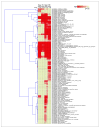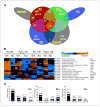The p53 tumor suppressor network is a key responder to microenvironmental components of chronic inflammatory stress
- PMID: 16288013
- PMCID: PMC1421332
- DOI: 10.1158/0008-5472.CAN-05-1714
The p53 tumor suppressor network is a key responder to microenvironmental components of chronic inflammatory stress
Abstract
Activation of the p53 network plays a central role in the inflammatory stress response associated with ulcerative colitis and may modulate cancer risk in patients afflicted with this chronic disease. Here, we describe the gene expression profiles associated with four microenvironmental components of the inflammatory response (NO*, H2O2, DNA replication arrest, and hypoxia) that result in p53 stabilization and activation. Isogenic HCT116 and HCT116 TP53-/- colon cancer cells were exposed to the NO* donor Sper/NO, H2O2, hypoxia, or hydroxyurea, and their mRNA was analyzed using oligonucleotide microarrays. Overall, 1,396 genes changed in a p53-dependent manner (P < 0.001), with the majority representing a "unique" profile for each condition. Only 14 genes were common to all four conditions. Included were eight known p53 target genes. Hierarchical sample clustering distinguished early (1 and 4 hours) from late responses (8, 12, and 24 hours), and each treatment was differentiated from the others. Overall, NO* and hypoxia stimulated similar transcriptional responses. Gene ontology analysis revealed cell cycle as a key feature of stress responses and confirmed the similarity between NO* and hypoxia. Cell cycle profiles analyzed by flow cytometry showed that NO* and hypoxia induced quiescent S-phase and G2-M arrest. Using a novel bioinformatic algorithm, we identified several putative p53-responsive elements among the genes induced in a p53-dependent manner, including four [KIAA0247, FLJ12484, p53CSV (HSPC132), and CNK (PLK3)] common to all exposures. In summary, the inflammatory stress response is a complex, integrated biological network in which p53 is a key molecular node regulating gene expression.
Figures






Similar articles
-
Gene expression profiles modulated by the human carcinogen aristolochic acid I in human cancer cells and their dependence on TP53.Toxicol Appl Pharmacol. 2008 Oct 1;232(1):86-98. doi: 10.1016/j.taap.2008.06.006. Epub 2008 Jun 25. Toxicol Appl Pharmacol. 2008. PMID: 18639569
-
Ribosomal protein S27-like, a p53-inducible modulator of cell fate in response to genotoxic stress.Cancer Res. 2007 Dec 1;67(23):11317-26. doi: 10.1158/0008-5472.CAN-07-1088. Cancer Res. 2007. PMID: 18056458
-
PBK/TOPK interacts with the DBD domain of tumor suppressor p53 and modulates expression of transcriptional targets including p21.Oncogene. 2010 Oct 7;29(40):5464-74. doi: 10.1038/onc.2010.275. Epub 2010 Jul 12. Oncogene. 2010. PMID: 20622899
-
p53 biological network: at the crossroads of the cellular-stress response pathway and molecular carcinogenesis.J Nippon Med Sch. 2006 Apr;73(2):54-64. doi: 10.1272/jnms.73.54. J Nippon Med Sch. 2006. PMID: 16641528 Review.
-
Rheumatoid arthritis and p53: how oxidative stress might alter the course of inflammatory diseases.Immunol Today. 2000 Feb;21(2):78-82. doi: 10.1016/s0167-5699(99)01552-2. Immunol Today. 2000. PMID: 10652465 Review.
Cited by
-
Integrative genomic analysis reveals widespread enhancer regulation by p53 in response to DNA damage.Nucleic Acids Res. 2015 May 19;43(9):4447-62. doi: 10.1093/nar/gkv284. Epub 2015 Apr 16. Nucleic Acids Res. 2015. PMID: 25883152 Free PMC article.
-
Multifaceted polo-like kinases: drug targets and antitargets for cancer therapy.Nat Rev Drug Discov. 2010 Aug;9(8):643-60. doi: 10.1038/nrd3184. Nat Rev Drug Discov. 2010. PMID: 20671765 Review.
-
Phosphorylated TP63 induces transcription of RPN13, leading to NOS2 protein degradation.J Biol Chem. 2010 Dec 31;285(53):41422-31. doi: 10.1074/jbc.M110.158642. Epub 2010 Oct 19. J Biol Chem. 2010. PMID: 20959455 Free PMC article.
-
Cyclin-dependent kinase activity controls the onset of the HCMV lytic cycle.PLoS Pathog. 2010 Sep 9;6(9):e1001096. doi: 10.1371/journal.ppat.1001096. PLoS Pathog. 2010. PMID: 20844576 Free PMC article.
-
p53 Contributes to Differentiating Gene Expression Following Exposure to Acetaminophen and Its Less Hepatotoxic Regioisomer Both In Vitro and In Vivo.Gene Regul Syst Bio. 2015 Jun 1;9:1-14. doi: 10.4137/GRSB.S25388. eCollection 2015. Gene Regul Syst Bio. 2015. PMID: 26056430 Free PMC article.
References
-
- Hofseth LJ, Hussain SP, Harris CC. p53: 25 years after its discovery. Trends Pharmacol Sci. 2004;25:177–81. - PubMed
-
- Hussain SP, Hofseth LJ, Harris CC. Radical causes of cancer. Nat Rev Cancer. 2003;3:276–85. - PubMed
-
- Li CQ, Robles AI, Hanigan CL, et al. Apoptotic signaling pathways induced by nitric oxide in human lymphoblastoid cells expressing wild-type or mutant p53. Cancer Res. 2004;64:3022–9. - PubMed
-
- Hussain SP, Amstad P, Raja K, et al. Increased p53 mutation load in noncancerous colon tissue fulcerative colitis: a cancer-prone chronic inflammatory disease. Cancer Res. 2000;60:3333–7. - PubMed
Publication types
MeSH terms
Substances
Grants and funding
LinkOut - more resources
Full Text Sources
Molecular Biology Databases
Research Materials
Miscellaneous

